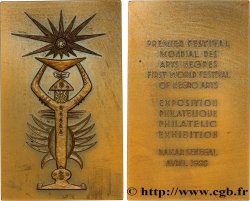fme_460726 - ANIMALS Médaille animalière - Rhinocéros
недоступный.
Товар уже продан в нашем интернет-магазине (2018)
Цена: : 200.00 €
Товар уже продан в нашем интернет-магазине (2018)
Цена: : 200.00 €
Тип Médaille animalière - Rhinocéros
Дата: 1971
Монетный двор / Город: France
Металл: copper
Диаметр: 80 mm
Гравер LÉCUYER Pierre (1933-
Вес: 224,70 g.
Век: lisse + corne CUIVRE 1971 N° 39/100
Комментарии о состоянии
Médaille en état neuf, avec une belle patine brune et brillante
Лицевая сторона
Аверс: легенда: ANÉPIGRAPHE.
Аверс: описание: Tête de rhinocéros à gauche.
Обратная сторона
Реверс: легенда: ANÉPIGRAPHE.
Реверс: Описание: Deux rhinocéros à droite, dans un environnement de savane, avec des oiseaux volant et posés sur leur dos.
Комментарий
Graveur plasticien, Jean Pierre LECUYER est né en 1940 dans les Vosges. Il est plus spécialisé dans la gravre sur bois, mais il réalisa aussi cette magnifique médaille en 1971 alors qu’à partir de 1965, il réalisa ses premiers bois gravés et débuta comme professeur d'éducation artistique...
Les rhinocéros sont les mammifères périssodactyles appartenant à la famille des rhinocérotidés (Rhinocerotidae). Toutes les espèces de rhinocéros sont actuellement menacées de disparition.
Les rhinocéros font localement l'objet d'une protection et de projets de réintroduction. Ils sont très utiles pour fertiliser le sol. Ils peuvent mesurer 4 m de longueur pour 1,50 m à 2 m de hauteur au garrot, et une masse pouvant avoisiner les 3 tonnes. Ce sont les plus gros mammifères terrestres actuels après l'éléphant. Les rhinocéros sont du même ordre que les chevaux et les tapirs, et non celui des éléphants. Leurs cris sont un barrissement, un grognement, un halètement. Le mot rhinocéros vient du grec rhinos, nez, et keras, corne, car il porte une ou deux cornes sur le nez, et non sur le front comme les autres mammifères cornus..
A visual engraver, Jean Pierre LECUYER was born in 1940 in the Vosges. He specializes more in wood engraving, but he also created this magnificent medal in 1971, while from 1965, he made his first woodcuts and began as an art education teacher... Rhinoceroses are perissodactyl mammals belonging to the rhinocerotidae family. All rhinoceros species are currently threatened with extinction. Rhinoceroses are locally the subject of protection and reintroduction projects. They are very useful for fertilizing the soil. They can measure 4 m in length by 1.50 m to 2 m in height at the withers, and a mass that can approach 3 tons. They are the largest current land mammals after the elephant. Rhinoceroses are of the same order as horses and tapirs, and not that of elephants. Their calls are a trumpet, a grunt, a gasp. The word rhinoceros comes from the Greek rhinos, nose, and keras, horn, because it has one or two horns on its nose, and not on its forehead like other horned mammals.
Les rhinocéros sont les mammifères périssodactyles appartenant à la famille des rhinocérotidés (Rhinocerotidae). Toutes les espèces de rhinocéros sont actuellement menacées de disparition.
Les rhinocéros font localement l'objet d'une protection et de projets de réintroduction. Ils sont très utiles pour fertiliser le sol. Ils peuvent mesurer 4 m de longueur pour 1,50 m à 2 m de hauteur au garrot, et une masse pouvant avoisiner les 3 tonnes. Ce sont les plus gros mammifères terrestres actuels après l'éléphant. Les rhinocéros sont du même ordre que les chevaux et les tapirs, et non celui des éléphants. Leurs cris sont un barrissement, un grognement, un halètement. Le mot rhinocéros vient du grec rhinos, nez, et keras, corne, car il porte une ou deux cornes sur le nez, et non sur le front comme les autres mammifères cornus..
A visual engraver, Jean Pierre LECUYER was born in 1940 in the Vosges. He specializes more in wood engraving, but he also created this magnificent medal in 1971, while from 1965, he made his first woodcuts and began as an art education teacher... Rhinoceroses are perissodactyl mammals belonging to the rhinocerotidae family. All rhinoceros species are currently threatened with extinction. Rhinoceroses are locally the subject of protection and reintroduction projects. They are very useful for fertilizing the soil. They can measure 4 m in length by 1.50 m to 2 m in height at the withers, and a mass that can approach 3 tons. They are the largest current land mammals after the elephant. Rhinoceroses are of the same order as horses and tapirs, and not that of elephants. Their calls are a trumpet, a grunt, a gasp. The word rhinoceros comes from the Greek rhinos, nose, and keras, horn, because it has one or two horns on its nose, and not on its forehead like other horned mammals.








 Cообщить об ошибке
Cообщить об ошибке Распечатать страницу
Распечатать страницу Отправить мой выбор
Отправить мой выбор Задать вопрос
Задать вопрос Consign / sell
Consign / sell
 Информация
Информация











